Goals and Objectives
This exercise was the culmination of the frac sand mining exercises we have been doing all semester, as well as an exercise in raster modeling. Using data we gathered in previous labs, we were to make a suitability model for frac sand mining in Trempeleau County by overlaying various raster data. We also found where high risk areas for mining were in the county.
Part 1
Methods
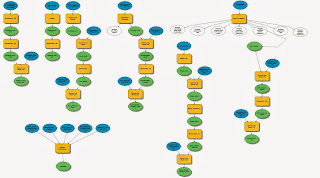 |
| Figure 1 - Work flow for part 1 |
It was necessary to use many different tools and data sets to compile the information needed to find suitable mining areas. The exercise was broken up into two parts: suitability and risk. For part one, we had to find suitable areas for mining using hill slope, geology, water table depth, land cover types, and proximity to railroad depots. We found these suitable areas separately, then used the tool 'raster calculator' to combine them into one suitability map. Figure 1 shows the work flow for this portion of the lab.

|
| Figure 2 - Suitable geology for frac sand mining |
For each map, we ranked suitability from 1-3, 3 being highest and 1 being lowest (or 0 being unusable) by reclassifying the raster data. For consistency, I used green for rank 3, yellow for rank 2, and red for rank 1 on all the maps.
When deciding what areas are suitable and what areas are not, it can vary from person to person. Geology, however, does not. Wonewoc and Jordan sandstone formations are suitable, so I did only one rank for that map (figure 2).
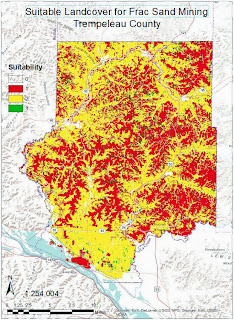 |
| Figure 3 - Suitable land cover sites |
For land cover, I ranked the suitable types by what areas were easiest to clear before mining can begin. This means that rank 3 included barren, shrub, and grass lands, Rank 2 was pasture and crop lands, and rank 1 was any type of forest land. I excluded any developed areas and wetlands entirely. Figure 3 shows the result.
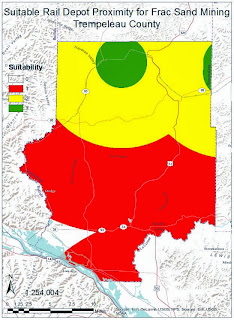 |
| Figure 4 - Suitable distance from rail depots |
Any sand mine will need a way of transporting the product, so we made a map showing suitable distance from rail depots. Rank 3 locations were any areas within 3 miles of a depot, rank 2 was between 3 and 10 miles away, and anything farther was rank 1. The map units were in meters, so I used the meter equivalent of these mile distances. To do this, I ran the 'euclidean distance' tool. Most of the maps I made only involved data that fell within our study area. However, I would think that frac mines in Trempeleau County would still be able to utilize rail depots in neighboring counties, so I included them when I ran the tool. It was only after I got the result that I used 'extract by mask' tool to show only suitable areas within our study area. I did have a mask set in the Environments menu, but it seemed to only work selectively, so I still had to run the tool occasionally. Figure 4 shows the result.
 |
| Figure 5 - Suitable slopes |
Hill slope is important when deciding an area to mine. Rank 3, the areas in green, are the most suitable areas with the lowest slope. The steepest areas in the study area are in red. Using a mosaiced DEM from a previous lab, I ran the slope tool and reclassified it to get the result in figure 5.
Once the sand has been mined, it must be washed to remove unwanted particles. For this reason, building a mine where the water table is close to the surface is preferable. Figure 6 shows where the water table is closest to the surface in green.
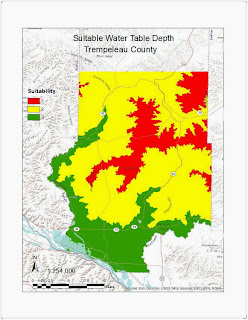 |
| Figure 6 - Suitable water table depth |
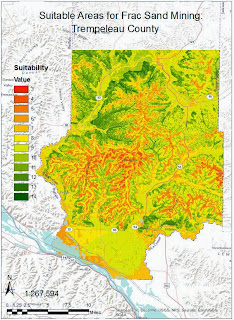 |
Figure 7 - Part 1 suitable areas
|
Results
Once I had the five separate suitability maps created, it was time to combine them to make one overall suitability map. To do this, I used the tool 'raster calculator' to add the values of all the layers. Since we used a constant suitability scale (0-3), the raster could be added together to give a range of suitability. Figure 7 shows the most suitable areas for frac sand mining in Trempeleau County, factoring in hill slope, water table depth, geology, distance from rail depots, and land cover type. As you can see in figure 7, the Northwest portion of the study area contains the most suitable areas for mining.
Part 2
Methods
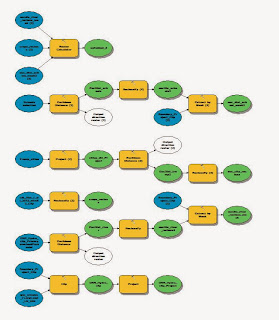 |
| Figure 8 - Work flow for part 2 |
Part two involved finding areas where mining would have the most impact, thus the most risk. This included proximity to streams, prime farmland, proximity to residential areas, and proximity to schools. I realized after creating the final risk map that I classified them backwards. The exercise called for ranking areas with highest risk at 3, and lowest risk at 1. I did all the maps in this section with low risk areas at rank 3 (thinking that low risk would be a more suitable area). Even with this mistake, risk can be clearly seen in the following maps. Figure 8 shows the work flow from Model Builder that I used.
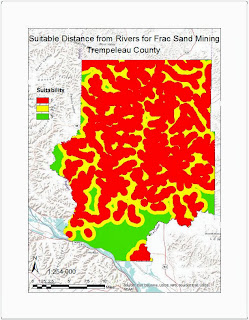 |
| Figure 9 - Suitable distance from major rivers |
There are many streams in the study area, and including all of them in this analysis would mean that there is no suitable area. I chose only primary perennial streams, since risk to these streams would have a larger effect on the area. I again used the 'euclidean distance' tool to create a raster ranking distance from streams, then reclassified it to have only three classes. Figure 9 is the finished map. As you can see, Trempaleau County has a great deal of rivers, making it difficult to find suitable areas.
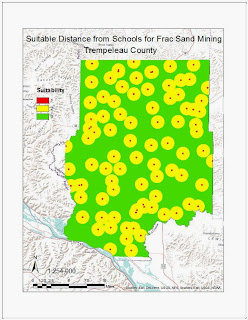 |
| Figure 10 - Risk index for area schools |
Because some people may not want a sand mine near schools for various reason, Figure 10 shows the risk model for schools within the study area. Rightfully so, schools are spread out evenly across the county, so in this case there is no specific region that stands out as more or less suitable. There is more than enough space between schools (shown in green), however, for mining. We also wanted to keep risk to prime farmland to a minimum. Figure 11 shows this risk map.
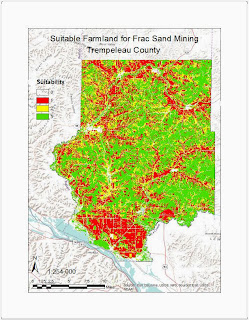 |
| Figure 11 - Risk to prime farmland from frac sand mining. |
Results
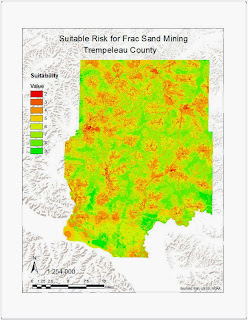 |
Figure 12 - High-low risk areas for mining. Red
represents areas of high risk, green is low risk. |
Figure 12 is the final product from part two. Again, the ranking is backwards from what we were supposed to use, but the map still does show areas where sand mining would put local areas at risk. This map was made by once again using the 'raster calculator' tool to combine the risk maps I had created by adding the pixel values.
We were also tasked with using the 'viewshed' tool to find if suitable mining locations would be visible from areas of our choice. I used the campground feature class to run the tool on. In figure 13, purple denotes what is visible from these campgrounds. This is overlaid on the final suitability map made by combining the products of parts one and two. Figure 14 is the finished product.
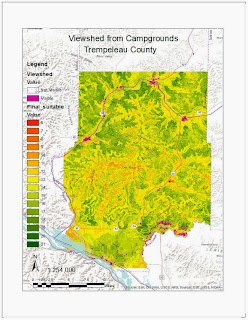 |
| Figure 13 - Viewshed of Trempeleau County campgrounds |
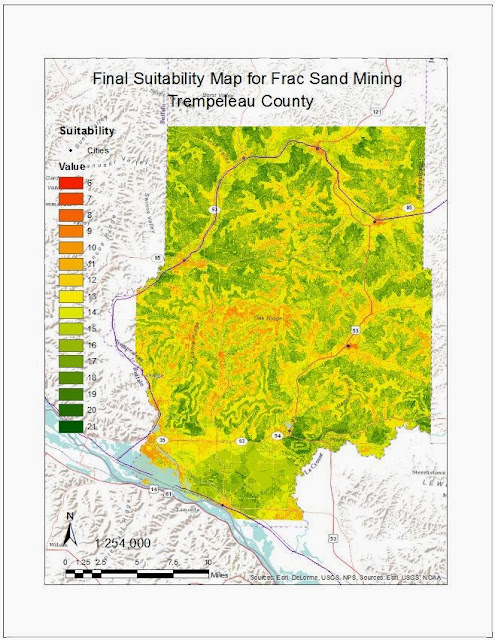 |
Figure 14 - This map is the final suitability map for
Trempeleau County including parts 1 and 2 |
Conclusion
I learned a great deal not only about using and interpreting GIS data, but also about frac sand mining during the course of this lab. Frac sand mining is a huge (and controversial) industry in Wisconsin. This was a lengthy exercise, but it tied everything we did this semester together very well. From my studies this semester, it seems that the northwestern portion of our study area would be the best place to scout new areas for frac sand mines.





























